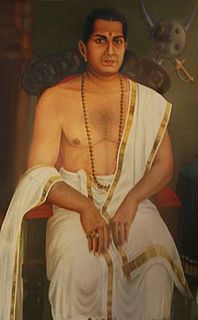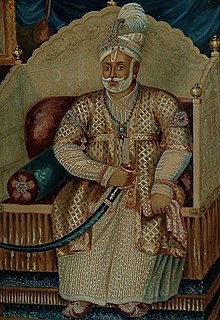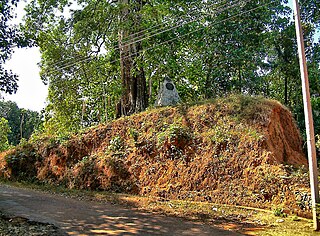This article needs additional citations for verification .(April 2022) |
Krishna Varma Raja was Eralpad or eldest prince of Calicut. He was known as Kishen Varma, Kishen Raja and Prince of Karimpuzha in British records.[ citation needed ]
This article needs additional citations for verification .(April 2022) |
Krishna Varma Raja was Eralpad or eldest prince of Calicut. He was known as Kishen Varma, Kishen Raja and Prince of Karimpuzha in British records.[ citation needed ]
Varma rose to power after Hyder Ali's second conquest of Malabar in 1774. Manavikraman Raja of Calicut fled to Travancore and thus his second-in-command Krishna Varma became de facto head of state. [1]
The oppressive Mysore rule pushed Malabar into a state of revolt that lasted throughout the Mysore period (1774 to 1791). The Kingdom of Calicut covered much of South Malabar. Varma and his nephews led resistance. Ravi Varma the Elder and Ravi Varma the Younger were most prominent. [1]
Krishna Varma operated from the traditional seat of Eralpad in Karimpuzha, present Palghat district, commanding a large resistance movement which took the form of guerrilla warfare. His nephew Ravi Varma the Elder acted as Commander In Chief of rebel military force. The rebels foiled all effort of Mysore government to set up a working administration in South Malabar. [2] [1]
In 1788, Varma went in person to Calicut to negotiate peace with Tipu Sultan but eventually decided not to cooperate with Sultan. To escape from Tipu's camp, he agreed to all proposals of Sultan and took a large sum from Tipu as reward, but once he fled to safety of Karimpuzha, he broke his promise and renewed his revolt on a greater scale. [1]
He died in 1793.

Hyder Ali, Haidarālī was the Sultan and de facto ruler of the Kingdom of Mysore in southern India. Born as Hyder Ali, from teeli cast of muslims, he distinguished himself as a soldier, eventually drawing the attention of Mysore's rulers. Rising to the post of Dalavayi (commander-in-chief) to Krishnaraja Wodeyar II, he came to dominate the titular monarch and the Mysore government. He became the de facto ruler of Mysore as Sarvadhikari by 1761. During intermittent conflicts against the East India Company during the First and Second Anglo–Mysore Wars, Hyder Ali was a military leader.

Valluvanad was an independent chiefdom in present-day central Kerala that held power from the early 12th century to the end of the 18th century. Prior to that, and since the late 10th century, Valluvanad existed as an autonomous chiefdom within the kingdom of the Chera Perumals. The disintegration of the Chera Perumal kingdom in early 12th century led to the independence of the various autonomous chiefdoms of the kingdom, Valluvanad being one of them.

Pazhassi Raja was known as Kerala Varma and was also known as Cotiote Rajah and Pychy Rajah. He was a warrior Hindu prince and de facto head of the kingdom of Kottayam, otherwise known as Cotiote, in Malabar, India, between 1774 and 1805. His struggles with the British East India Company is known as the Cotiote War. He is popularly known as Kerala Simham on account of his martial exploits.

Dharma RajaKarthika Thirunal Rama Varma was the Maharajah of Travancore from 1758 until his death in 1798. He succeeded his uncle Marthanda Varma, who is credited with the title of "maker of modern Travancore". During his reign Dharma Raja not only retained all the territories his predecessor had gained but administered the kingdom with success. He was addressed as Dharma Raja on account of his strict adherence to Dharma Sastra, the Hindu principles of justice by providing asylum to thousands of Hindus and Christians fleeing Malabar during the Mysorean conquest of Malabar.

Nedumkotta or Travancore lines was a wall built as a protection against consistent invasion and threats from northern kingdoms mainly Tipu Sultan of Mysore. It was built by the Dharma Raja Karthika Thirunal, King of Travancore with the request, support and permission of the Kingdom of Kochi. It was constructed by Rama Varma under the supervision of his Commander Eustachius De Lannoy. The work was started in 1762 it was completed only by 1775. The lines consist of a ditch about sixteen feet broad and twenty feet deep with a thick bamboo hedge in it, a slight parapet and good rampart and bastions on rising grounds almost flanking each other from one extreme of the lines to the other. The construction of Nedumkotta or the Travancore Lines is considered to be a unique and unparallel episode in Indian History by historians.

The Samoothiri was the hereditary monarch of the kingdom of Kozhikode (Calicut) on the South Malabar region of India. Calicut was one of the important trading ports on the south-western coast of India. At the peak of their reign, the Zamorins ruled over a region from Kollam (Quilon) to Panthalayini Kollam (Koyilandy).

Parappanangadi, IPA: [pɐɾɐpːɐn̺ɐŋːɐːɖi], is a major town and a municipality in Tirurangadi taluk of Malappuram district, Kerala, India. It is a coastal town located close to the Arabian sea. Parappanangadi railway station is one of the oldest railway stations in Kerala. It was a part of the first rail route (Tirur–Chaliyam) in Kerala. Parappanangadi is located 9 km (5.6 mi) north of Tanur on Tirur-Kadalundi Tipu Sultan Road. The town lies on the bank of Kadalundi River. Parappanangadi town is located north of the estuary of Poorappuzha River, which is a tributary of Kadalundi River, and south of the estuary of Kadalundi River, which lies in Vallikkunnu. Parappanangadi was one of the major ports in the southwestern coast of India during the medieval period. It was ruled by the kingdom of Parappanad, who were vassals to the Zamorin of Calicut, and had the jurisdiction up to Beypore port to the north. In the early medieval period, under the chiefs of Kozhikode and Parappanangadi, Parappanangadi developed as one of the important maritime trade centre on the Malabar Coast. Later it became a part of Eranad Taluk in Malabar District under British Raj.
The Captivity of Kodavas (Coorgis) at Seringapatam was the period of capture, deportation, and imprisonment of Kodava Takk speaking Coorgis who rebelled against Tippu Sultan, the de-facto ruler of the Kingdom of Mysore, they were caught during a number of attempts to suppress their rebellion in the 1780s.
The Captivity of Nairs at Seringapatam was imposed on the Nairs of Malabar by Tipu Sultan, the de facto ruler of the Kingdom of Mysore from 1786 to 1799. They were subjected to forcible conversions to Sunni Islam, the official religious sect sanctioned by the Ottoman Caliphate, whose approval and alliance was sought by Tippu Sultan. those who refused conversions had to face many humiliations, hardships, torture, and even death. The Nairs were treated with extreme brutality due to their strong adherence to the Hindu faith and martial tradition. The captivity ended when Nair troops from Travancore defeated Tipu in the Third Anglo-Mysore War. It is estimated that out of the 30,000 Nairs put to captivity, only a few hundred returned to Malabar alive.
Sankara Varman (1774–1839) was an astronomer-mathematician belonging to the Kerala school of astronomy and mathematics. He is best known as the author of Sadratnamala, a treatise on astronomy and mathematics, composed in 1819. Sankara Varman is considered as the last notable figure in the long line of illustrious astronomers and mathematicians in the Kerala school of astronomy and mathematics beginning with Madhava of Sangamagrama. Sadratnamala was composed in the traditional style followed by members of the Kerala school at a time when India had been introduced to the western style of mathematics and of writing books in mathematics. One of Varman's contribution to mathematics was his computation of the value of the mathematical constant π correct to 17 decimal places.

The Battle of Nedumkotta took place between December 1789 and May 1790, and was a reason for the opening of hostilities in the Third Anglo-Mysore War. This battle was fought between Tipu Sultan of the Kingdom of Mysore and Dharma Raja, Maharaja of Travancore. Mysore army attacked the fortified line in Thrissur district at the Travancore border known as the Nedumkotta. The Mysore army was successfully repulsed by the Travancore army under the leadership of Raja Kesavadas, Dewan of Travancore.
The Siege of Tellicherry was a military embargo that happened in Thalassery. The Commander in Chief of the Mysore Calicut Province, Sirdar Ali, took siege of the British Military Barrack of Thalassery for 18 months. They British and the local administrators were blockaded within Thalassery by land as well as by sea. It was during the Second Anglo-Mysore War. The siege continued until reinforcements from Bombay under the command of Major Abington attacked the Mysore army and defeated them. Major Abington then moved south, capturing Calicut. The Siege of Tellicherry led to the fall of strongholds of the First Mysore conquest, led by Hyder Ali. Even though laterTipu Sultan came from Mysore to reinstate the conquered area to previous status.

The Mysorean invasion of Malabar was the military invasion of the Malabar region of the current Kerala state, including the territories of the Zamorin of Calicut, by the de facto ruler of the Kingdom of Mysore, Hyder Ali. After the invasion, the Kingdom of Cochin south of Malabar became a tributary state of Mysore.
The Mysore's campaigns against the states of Malabar was the result of the Calicut's attack on Palghat in 1756–1757. This comprised the attacks of the Zamorin of Calicut on the Kingdom of Palakkad, situated east to Calicut. It was a continuation of the attacks on the Kingdom of Valluvanad, the traditional rival of Calicut. In the one sided Valluvanad attacks the Zamorin had captured much of the land from Eranad to Nedunganad. So, this time Zamorin marched against Palakkad and easily occupied Nadvattom which tore the Kingdom of Palakkad right through the middle.
The British got Malabar from Tippu Sultan in 1792. But Malabar was a province that was plagued by refraction, unrest and insurgency as early as 1766—when Hyder Ali occupied whole of Malabar. Two decades of Mysore effort to subjugate this province ended up in chaos and confusion in Malabar with a part of her population either dead or migrated and once prosperous economy destroyed.
Ravi Varma Raja (1745–1793) was a Samantan Nair warrior prince of the Royal House of Zamorins from Calicut who fought a two-decade long revolt against the Mysore Sultanate under Hyder Ali and Tipu Sultan between 1766–1768 and 1774–1791, and later the British East India Company in 1793.

The Kozhikode, also known as Calicut, was the kingdom of the Zamorin of Calicut, in the present-day Indian state of Kerala. Present-day Kozhikode is the second largest city in Kerala and the headquarters of Kozhikode district.
Malappuram is one of the 14 districts in the South Indian state of Kerala. The district has a unique and eventful history starting from pre-historic times. During the early medieval period, the district was the home to two of the four major kingdoms that ruled Kerala. Perumpadappu was the original hometown of the Kingdom of Cochin, which is also known as Perumbadappu Swaroopam, and Nediyiruppu was the original hometown of the Zamorin of Calicut, which is also known as Nediyiruppu Swaroopam. Besides, the original headquarters of the Palakkad Rajas were also at Athavanad in the district.
Thalassery was a trade hub where Chinese, Arab, and Jewish traders had considerable influence in the spice market before that the Greeks and Romans was in the trade. It was the European invasion that brought significant change as they enforced the trade with their military.

Neerazhi Palace was the royal palace of the Thekkumkur kingdom. Palace is located at Puzhavathu in Changanassery. The palace was used by the Thekkumkur dynasty until 1750 and later by the Parappanad dynasty who settled in Changanassery from North Malabar. It was here that the last king of Thekkumkur, Aditya Varman Manikandan escaped to Nattassery of Kottayam in the Travancore invasion of 1790. The Neerazhi palace was earlier known as Neerazhikettu.
Logan, William (1887). Malabar manual, Volume 1. Asian Educational Services. ISBN 978-81-206-0446-9. Retrieved 2012-11-14.